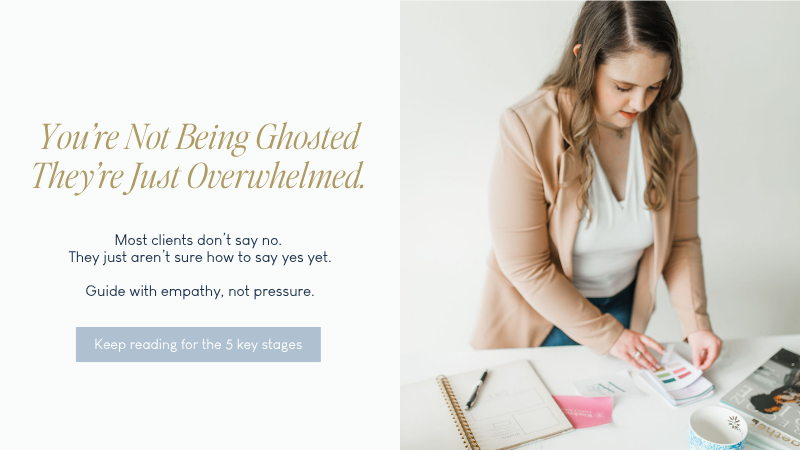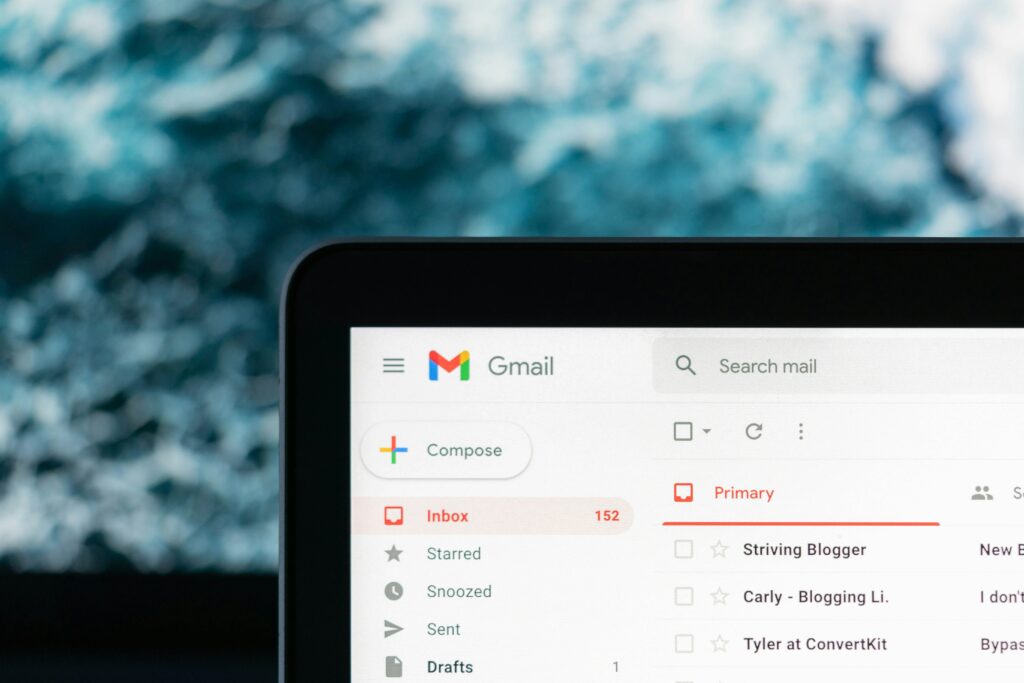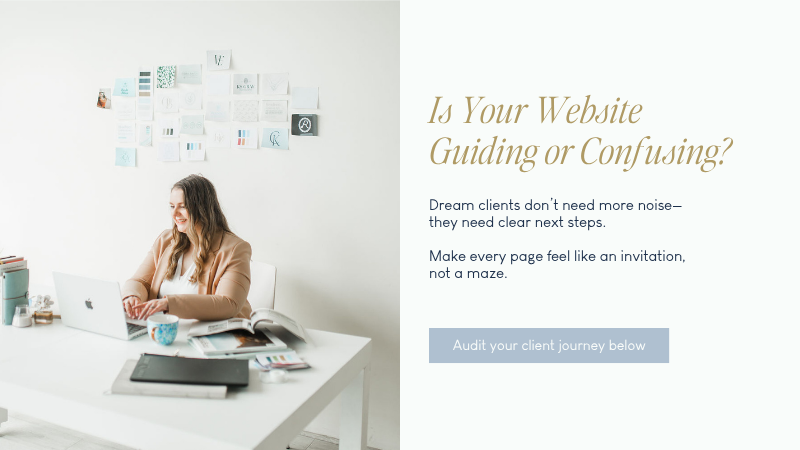If you’ve never taken the time to outline your client journey map, you might be missing the secret to consistently attracting and booking your dream clients.

Before we dive in—let’s talk podcast. This blog is based on Episode 14 of my Engage Your Brand® podcast, so if you’re a listener or want to hear it in my own voice, be sure to tune in:
🎧 Listen to this episode:
- Apple Podcasts
- Spotify
- Or listen right here on the blog!
What Is a Client Journey Map—and Why Should You Care?
If you’ve ever had a dream client inquire with you… only to ghost you after seeing your website, or maybe you’ve jumped on a call with someone and instantly knew you weren’t the right fit—this post is for you.
A client journey map is your blueprint for understanding why some clients eagerly book and rave about you, while others fade into the void. It traces every touchpoint your client has with your business—from the moment they discover you to the time they become loyal advocates who can’t stop singing your praises.
And in the wedding and event industry, this is gold. You don’t usually get repeat business from the same client—but you do have the power to attract their best friend, their sister, their coworker. Mapping your client journey doesn’t just make your marketing better—it helps you build deeper, more aligned connections that naturally lead to referrals.
Why Clients Say “No” (Even When They’re a Perfect Fit)
We tend to think clients ghost us because they weren’t serious or weren’t ready, but in reality, it might have nothing to do with them—and everything to do with the way you’ve positioned your business. If your website feels unclear or overwhelming, if your offers don’t feel approachable, or if you’re assuming they already know what they want—you’re creating friction.
The truth is, many clients don’t know what they want when they start planning. They’re navigating new decisions, budget conversations, emotional dynamics, and a huge amount of information. Your job as a service provider and brand is to guide them—not rush them. That’s exactly where the client journey map comes into play.

The Five Core Stages of the Client Journey
Let’s walk through the five key stages that almost every client—whether wedding, social, or corporate—moves through:
1. Awareness – The “I Just Got Engaged and I’m on Pinterest at 11pm” Phase
This stage is early. Very early. It’s when your potential client is just starting to imagine what their event might look like. They’re collecting ideas, not making decisions. At this point, a hard pitch is more likely to turn them off than pull them in.
Your focus here should be building brand visibility, offering inspiration, and earning trust. This is where content like blog posts, Pinterest pins, Instagram reels, freebies, and lead magnets shine. Think: how can I show up with value that asks for nothing in return?
✨ Tip: If you offer too much commitment too soon (like a promo they have to book within a week), you’ll risk overwhelming them. Instead, try offering a freebie or low-pressure lead magnet they can engage with on their own time.
2. Exploring – Opening All the Tabs
Once your potential client has defined some preferences, they start shopping around. They’re checking out websites, comparing styles, and evaluating price ranges. This is when your website really starts to matter.
They’ll ask themselves:
- Do I like this person?
- Can I see myself working with them?
- Is this brand visually aligned with my style?
- Do I feel confident and safe moving forward?
You want your website to act like a gracious host—welcoming them in, making them feel understood, and guiding them to the next step with clarity and ease.
3. Inquiry – Make Contact and Make It Easy
This is where your systems matter just as much as your visuals. If someone fills out your contact form and doesn’t hear from you for several days, you’ve likely lost them. On the flip side, a warm, thoughtful auto-response with helpful links or next steps? Game-changer.
Use a CRM like Dubsado or HoneyBook to automatically send personalized messages the moment an inquiry comes in. And remember—don’t make it all about you. Keep the email focused on them—their event, their excitement, and how you’ll walk alongside them.
✨ Pro Tip: Include blog posts or Instagram content in your auto-response that nurtures them further. Even a quick video or voice message can work wonders in keeping the conversation going.

4. Working Together – Your Time to Deliver
Once they’ve signed on, this is your moment to shine—and stay consistent. A client experience that aligns with your brand voice and promises will reinforce trust and turn one-time clients into long-term advocates.
This is where branded documents, smart workflows, timely updates, and proactive communication come into play. If your website and inquiry process felt elevated and calm, but your emails now feel rushed and chaotic, they’ll feel the disconnect.
✨ Make it seamless: Carry your brand colors, fonts, and tone into every part of your backend systems. From your welcome guide to your email signature, everything should feel intentional and cohesive.
5. Raving Fan Era – Turn Clients Into Advocates
You might never work with them again, but that doesn’t mean your relationship is over.
Staying top-of-mind after the project is done is what turns a happy client into a referral machine. Follow up after the event, send a gift, comment on their Instagram milestones. Stay connected.
Even better? Set up a referral program. Whether it’s a gift card, a small commission, or just a heartfelt thank-you, showing appreciation for referrals makes clients feel seen and valued—and they’ll be more likely to send future business your way.
Emotions Drive Decisions: Don’t Overlook the Psychology
Let’s talk about what’s really happening behind the scenes during your client journey: emotions.
Your clients are making big decisions. And most of those decisions are emotionally driven—even when they appear logical. Maybe they “feel overwhelmed,” or “need more time,” or just “don’t feel a connection.” All of these are emotional cues.
That’s why your brand tone, your words, and your visuals need to support calm, trust, and ease. From the moment they see your Instagram bio to the thank-you email after you deliver their gallery or event—how they feel matters more than what you say you offer.
Brand Consistency = Brand Recognition
Another huge takeaway from the client journey map? Consistency creates trust.
If your Pinterest, Instagram, and website all feel like totally different businesses, your client will get confused—or worse, forget you entirely. You want every single platform to sound, look, and feel like you.
That way, by the time they’re on touchpoint #7, they instantly recognize your name, remember their experience, and know they’re in the right place.
Every consistent brand touchpoint reinforces trust—and helps complete a stronger, more strategic client journey map.
✨ Quick tip: Use the same brand voice in your auto-response as you do on your website homepage. Small details build big trust.
Where Website Clarity Often Breaks Down
One of the biggest areas people lose clients? Confusing websites.
Here’s what I often see:
- Packages that don’t make sense or aren’t explained clearly
- Buttons labeled “Start Here” but lead to vague pages
- Beautiful visuals… but no personality or connection
- Pricing hidden or difficult to find, which makes people bounce
Your website should act like a guide. It should help people self-identify: “Yes, I belong here.” “Yes, this is what I need.” “Yes, I can afford this.” Clarity builds confidence. And confident people book.

Your Client Journey Map Audit Checklist
Want to do a quick audit? Ask yourself:
Do I have top-of-funnel content for people who are not ready to book yet?
Does my brand voice stay consistent across my platforms, emails, and proposals?
Are my services clearly listed, easy to understand, and visually engaging?
Is it simple for someone to contact me or book a discovery call?
Am I following up quickly—and warmly—when someone inquires?
After the project wraps, do I continue nurturing that connection?
Have I made it simple and natural for happy clients to refer me?
If you answered “no” to a few of these, that’s okay—it just means you’ve got places to grow. Start with one small change, and your client experience will start improving fast.
The Power of Passive Touchpoints
Some of the most valuable moments in the client journey happen when you’re not even actively marketing.
A past client shares their wedding gallery and tags you. A blog post you wrote six months ago ranks on Google. A podcast episode plays while someone is folding laundry. These are passive touchpoints—and they matter deeply.
You don’t have to constantly “sell” to be top of mind. You just need to be findable, memorable, and consistently present across platforms your dream clients already use.
Even just one high-ranking blog post or Pinterest pin can bring people into your world long before they’re ready to book—and that’s where trust begins.
Offer Curiosity, Not Pressure
A common mistake creatives make? Assuming every interaction needs to convert immediately.
That’s simply not how people buy. Especially in the wedding and event space, your clients are thoughtful, emotional, and often overwhelmed. They don’t want pressure. They want reassurance.
So instead of pushing the sale at every step, focus on inviting curiosity. Offer helpful content, answer their questions without strings attached, and let your presence do the nurturing.
By the time they’re ready to invest, you’ll already feel like a trusted guide—not just another vendor.
The Seven Touch Rule: Why Visibility Beats Perfection
Here’s something to remember when you start feeling frustrated that your dream clients aren’t taking action fast enough: it takes, on average, seven touchpoints for someone to make a decision. That means they need to encounter your brand seven different times—whether through your website, social posts, email newsletters, or a referral from a friend—before they even consider booking.
So if someone doesn’t inquire the first time they visit your site, that doesn’t mean they’re not interested. It just means they’re still on the path. Your job isn’t to close the sale on the first click—it’s to create consistent, memorable, trust-building moments over time.
That’s why top-of-funnel content (think: blog posts, educational freebies, engaging reels, Pinterest pins) matters just as much as your pricing page. It’s the slow drip that builds familiarity—and that familiarity is what leads to action.
Tiered Offers Aren’t “Discounting”—They’re Strategy
Let’s debunk a myth: having multiple offers isn’t about lowering your value. It’s about meeting people where they are in their decision-making journey. When someone isn’t ready to dive straight into your highest-tier offer, you can still guide them into your world through a smaller, lower-commitment service—and that’s incredibly smart.
If you only offer one thing and it’s high-ticket, you’re unintentionally filtering out dream clients who simply need more clarity before they commit. But with a tiered approach, you create a natural entry point for them to take the next step.
Think of it like this:
- Your entry offer might be a 1:1 consultation, venue sourcing, or planning session.
- Your core offer is the package you want to sell most—your signature service.
- Your elevated offer is for clients who want everything: VIP service, multiple day coverage, or highly personalized experiences.

Having options gives your client autonomy. It also allows your brand to guide, not push—creating a client experience that feels empowering from the start.
Is Your Brand Guiding or Confusing?
Your website isn’t just a place to showcase your work. It’s your digital storefront—and your job is to make it feel as intuitive as walking into a beautifully designed space where everything flows naturally. If someone lands on your site and immediately feels confused about where to go, what to do, or how to work with you, they’re going to click away.
Ask yourself:
- Are your services clearly broken down into steps or tiers?
- Does your copy speak to where someone is in the journey?
- Are your visuals matching the tone of your best work?
- Does your site answer common client questions without overwhelming them?
If your brand visuals are polished but your website layout is chaotic, or your messaging sounds beautiful but your contact process is clunky, there’s a disconnect. That disconnect creates doubt—and doubt stalls decision-making. A clear client journey, on the other hand, builds confidence at every click.
Listen to the Full Episode
Want the full breakdown with more real-life examples and actionable tips? Listen to Episode 13 of Engage Your Brand®:
🎧 Apple Podcasts
🎧 Spotify
🎧 Or listen right here on the blog 👇
If you found this post helpful, share it with a vendor friend who’s working on refining their client experience. And if you haven’t already, leave a review on the podcast—it helps us reach more creatives just like you.
Want to hire an expert team to help you identify your ideal client? Reach out to us!
Leave a Reply Cancel reply
We respect your privacy.
Copyright Emily Foster Creative, LLC. 2021 - 2025. All rights reserved.
hello@emilyfostercreative.com
Brand photography by Lena Crocker Photo, Ciara Corin Photo, Moon & Honey Photography and Enliven Photography
Powered by podcasts and tea.
Designing out of Portland, Oregon for creatives around the world.
Be the first to comment